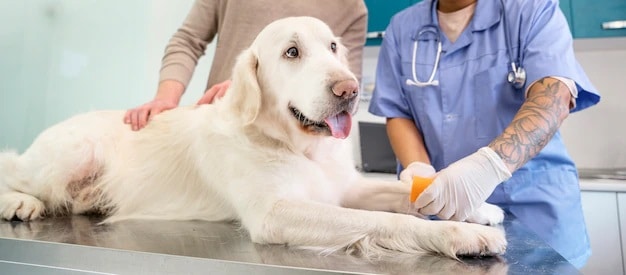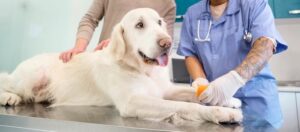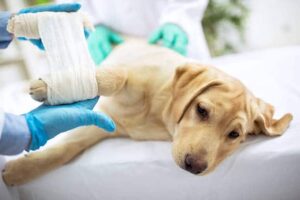Dogs are hypercreative creatures that twist, run, and jump anywhere around! Sometimes a wrong movement drives lameness in the hind legs. This over-extending and over-rotating motion in the knee joint causes swelling and pain in the ligaments. It eventually reduces mobility and makes it difficult for dogs to walk.
Do you know why this happens?
The cranial cruciate ligament (CCL) tears or ruptures in the knee joint. It often happens because of ligament degeneration, genetics, obesity, and the dog’s poor physical condition. The CCL in dogs is the same as the ACL in humans.
To treat or repair torn ACL in a dog, surgery is the best approach. The most common surgical options include the lateral suture technique or extracapsular repair, tibial tuberosity advancement (TTA), and tibial plateau levelling osteotomy (TPLO). Veterinary Specialists perform a common surgery ACL on the knee.
In this Guide, we’ve compiled comprehensive information on ACL surgery options to help you make the best choice for your dog.
Without any further ado, let’s get started!
What is ACL Surgery for Dogs?
In dogs, Cranial Cruciate Ligament binds the femur to the tibia. The ligaments cross over one another, allowing the knee to function as a joint. Any injury or chronic condition, including tears and ruptures, requires ACL surgery to regain the knee functioning.
Take a look at some of the symptoms a dog faces on Torn Cranial Cruciate Ligament.
Symptoms of Torn Cranial Cruciate Ligament
- Trouble While Jumping
- Difficulty on Rising
- Lameness
- Stiffness
- Swelling in Knee
- Decreased Muscle Mass in the Knee Joint
- Reduced Mobility
- Lowered Activity Level
- Loud Popping Sound
Causes of Torn Cranial Cruciate Ligament
The most common causes of Torn Cruciate Ligament Includes:
1) Genetics
A mutation affects the genes and increases the chances of causing the tear and ruptures in the cruciate ligament due to genetics. Improving the dog breed’s genetic health by examining and monitoring the physical health decreases the chances of getting ACL ruptures.
2) Obesity and Poor Fitness
Sometimes dogs suddenly change direction while moving, and the majority of weight comes to the knees. The shearing forces put pressure on the cruciate ligaments and cause injuries. If the dog is fit and healthy, the knee gets enough support and stabilizes the legs during weight-bearing activities.
3) Aging and Degeneration of the Ligament
The stress on the knee develops damage in the ligaments. It occurs due to pre-existing medical conditions and causes cranial cruciate ligament disease in dogs.
4) Certain Dog Breeds at the Higher Risk of Torn ACL
Certain dog breeds, including Newfoundland, Saint Bernard, Mastiff, Chesapeake Bay Retriever, Staffordshire Terrier, Labrador Retriever, and more, are at a higher risk of causing torn ACL.
Treatment Options for ACL Tears in Dogs
Many treatment options are available when a dog is diagnosed with ACL surgery. Veterinarian doctors suggest surgical and non-surgical treatments depending on the type of injuries and other factors.
A doctor considers these factors before choosing the right treatment procedure for the Dogs knee restoration. It includes –
- Dog’s Age
- Size
- Weight
- Procedure Cost
- Surgical Procedure Preferred by the Surgeon
Surgical Treatment Procedures for a Torn ACL

Here are a few ACL Surgery procedures to cruciate repair in dogs.
1) Lateral Suture Technique or Extracapsular Repair
The lateral Suture or Extracapsular Repair is the most popular technique. It uses a strong suture in a similar orientation to the original ligament to secure the joint. The dog knee surgery facilitates the formation of new scar tissue around the joint to gradually stabilize the stretches and breaks.
Pros
- Typically, Cost-Effective Process
- No Bone Incisions on Dogs
- Doesn’t Requires Specialized Training to Perform the Process.
- Ideal for Small Breed Dogs
2) Tibial Tuberosity Advancement (TTA)
TTA procedure involves treating cranial cruciate ligament rupture in the dog’s knee joints. The orthopedics performs the procedure by cutting the tibia’s top and moving it to stabilize the shin bone in the new position.
Pros
- Better Option
- Ideal for Dogs weighing over 50 lbs.
3) Tibial Plateau levelling Osteotomy (TPLO)
In the TPLO procedure, an incision is performed on the dog’s tibia. It is then rotated till it attains a perpendicular orientation relative to the quadriceps muscles with the help of the plate and screws. It changes the anatomy of the dog’s body so that its body naturally supports the procedure and enriches the joint’s stability. The screws and plates are removed only if it causes any irritation or infection to the dog.
Pros
- Ideal for Larger Dogs
- Best Outcomes for Limb Functionality
- Increased Mobility
Non-Surgical Treatment Options for a Torn ACL
For partially torn ACL, dog owners can go for conservative procedures. However, for a completely torn ACL, surgical procedures are required.
The conservative procedures repair ACL by strengthening the muscles. Some of the options include:
- Dog Knee Braces: Dog owners opt for knee braces when it comes to a surgery alternative. Knee braces provide the maximum support to the knee structure of the dog’s leg. The non-rigid brace stabilizes the knee joint and keeps the knee in place so that scar tissue forms a callus over the tear and heals ACL.
- Restricting Dog Activities: Restricting the moving activity of the dog and giving proper rest allows the body to heal naturally. The veterinarian advises the dogs not to jump, run, twist, or turn.
- Using Non-steroidal anti-inflammatory drugs & Anti-inflammatory supplements: The pain of a torn ACL is unbearable. The medicines and supplements are quite helpful in healing the ligament. The non-steroidal anti-inflammatory drugs & anti-inflammatory supplements relieve the pain in dogs. The side effects of these drugs and supplements are multiple, but low-dose usage is safe for dogs.
- Reducing Body Weight: High body weight of the dog is the leading cause of ACL injury. The dog is unable to take the extra stress on the ligament, and the ACL gets torn. Dog owners can accelerate the healing process by lowering the dog’s body weight. The low body weight reduces the pressure on the ligament and heals the knee joint faster.
- Rehabilitation Therapies: Rehabilitation therapies speeds up the healing process. The range of movement and mobilization therapies performed under the guidance of an expert gradually improves and strengthens the muscles.
- Physical therapy: When a dog starts regaining mobility, the veterinarian suggests exercises to strengthen the ligaments. Reliable physical therapy helps the dog to recover from a partially torn ACL.
How Long Does Dog ACL Surgery Take for Recovery?
The dog ACL surgery recovery time depends on various factors.
- The type of surgical procedure performed on the dog.
- For how long was the tear present in the ligament?
- Inflammatory variations in the joints.
In most cases, the dog returns the same day from the hospital—the Overall ACL tear recovery time varies from dog to dog. The dogs are more likely to recover within 8-12 weeks with the introduction of physical activities in dogs. However, it takes six months for dogs with chronic ACL tears to heal after the surgery.
Dog ACL Surgery Aftercare
During the post-operative period, the swelling of the knee moves down the leg towards the ankle joint. The veterinarians suggest the dogs to wear cones at all times because the dogs lick and chew the surgery area. It increases the chances of infections in dogs.
There are a plethora of plastic cones available in the markets. Try avoiding plastic cones as they leave dogs scratching up their legs. Use a surgery recovery suit, a plastic cone alternative to ease movements in dogs.
The recovery suits are lightweight and have cotton fabric to comfort the dogs. Moreover, the inflatable collar and little pump protect the dog from foxtail.
Dog owners can do the following to recover their dogs soon!
Monitor Implants Regularly
The dog owners must monitor the redness, excessive swelling, inflammation, odor, or pain post-surgery. These are infection signs that require medical attention. Dog owners can prevent these risks in dogs by keeping a close eye on the signs by monitoring implants regularly.
Administer Medications
The veterinarians prescribe non-steroidal anti-inflammatories that have certain side effects. Dog owners can ease the pain by using cold compresses on the knee. It comforts the dog and reduces swelling in the dog post-surgery.
Lubricate Joints with Range of Motion Exercises
The range of motion exercises articulates joint surfaces healthy. It provides stability and reduces the load on the cruciate ligament. Encourage the dog to perform the activities under the guidance of the specialist for fast recovery.
Visit for Follow Up Appointments
Visit the veterinarian specialist at regular intervals for follow-up appointments. During these follow-ups, the specialists examine the ligaments and prescribe the medications and therapies for a speedy recovery.
How much does ACL Surgery Cost for Dogs?
The dog cruciate ligament surgery cost leans on several factors, including surgical procedures performed and the location of the services taken. Some dogs heal with braces and anti-inflammatory medications, while others require surgical operations to recover.
Depending on the severity of the ligament breakage, overall cost estimates for the surgeries are evaluated based on the following:
- Diagnostic & Post-Operation X-Rays
- Surgery
- Plates and Screws
- Epidurals
- Overnight Hospitalization and Care
- IV fluids
- Medications
- Sutures and Surgical Supplies
- Cones
- Follow Up Appointments
ACL Health Prevention Tips for Dogs
ACL injuries significantly reduce the quality of life of dogs. Following a few preventive tips can reduce the discomfort and pain a dog experience with a torn ACL.
Ensure Your Dog is Comfortable
Keep an eye on the dog to confirm whether it eats and rests comfortably or not. Check the sleeping area to ensure the dog doesn’t jump that high. Relocate the mattress to the floor temporarily to make sure that the dog is not uncomfortable while resting.
Keeping Wounds Clean and Protected
Clean the wounds and cover them to prevent bacterial infections. It reduces exposure and prevents complications.
Introducing Joint Supplements to Dogs
Healthy joints, ligaments, and tissues in the knee are less prone to injuries. Introducing joint supplements to dogs in daily routine significantly reduces the chances of getting knee injuries. The Joint supplements prevent joint degradation, lowers inflammation, and improve mobility in dogs. The dog lives an active lifestyle and enjoys a better quality of life with healthier joints and ligaments.
Regular Exercising
Every dog has a different fitness level. Exercising regularly with customized exercise plans based on specific breed type builds good muscle health in dogs. It prevents injuries in dog breeds that are more prone to get ACL injuries.
Give a Balanced Diet to Your Dog
Offering a balanced diet to dogs prevents the onset of various diseases and injuries. Make sure you give food to dogs with a good amount of protein, minerals, vitamins, and Omega-3. The nutrients like minerals and vitamins in a dog’s diet plan build healthy muscles and ligaments from the inside out. The protein intake helps to repair tissue growth. Including a balanced diet provides extra supplements to the dog’s body and reduces the chances of an ACL injury.
Avoid Unnecessary Jumping in Dogs
Jumping on and off the surfaces slightly rotates the shin bone. Excessive stress on the joint may lead to an ACL sprain or tear. Avoid unnecessary jumping to prevent the dogs from getting any wear and tear in the joints.
Work on Weight Management
Weight loss in dogs is the foremost thing that decreases the risk of an ACL injury. Try to work on weight loss management plans to improve the dog’s health and muscle strength.
How can we help?
Is your four-footer limping on the leg and struggling to stand up? Is there any stiffness in the knee joint? Recognize the early signs and schedule an evaluation from a veterinarian. The specialists will suggest various treatment options based on injury severity.
If the dog is having ACL surgery or is still recovering, get a surgery recovery suit from Big Dogs’ Closet. The super comfortable recovery suit is 95% cotton-made and is great for the surgery site. It provides full coverage to the surgical area and prevents the dog from licking the site. Eventually, reducing the risk of getting an infection at the surgical site.


